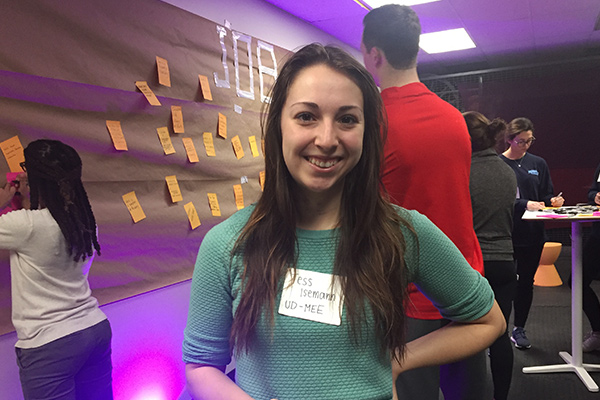Dayton Engineer

Engineering Students Work Across Disciplines to Address Dayton Opioid Epidemic
By Kelly Mofield, School of Engineering
A large group of students, city officials, addiction service providers and people in recovery, economic development leaders, and workforce development professionals, among others, gathered last week at Fitz Hall. The group was brainstorming ideas for a recycling enterprise for Montgomery County and city buildings to provide jobs with a purpose for people in recovery or newly released from prison.
The session was held in the GEMnasium (Growth, Education, Mindset), a creative space that marries chain link walls with nightclub lighting and a dash of yoga studio Zen. It is one of many “collision events” bringing together students, faculty and community partners across disciplines to address and begin the process of solving real community problems, while at the same time enhancing the education of students from all disciplines.
According to Kevin Hallinan, professor of mechanical and aerospace engineering and director of Energy and Sustainability Informatics Center, the idea for a vehicle to promote transdisciplinary education came out of the Collaboration Accelerator, a summer cross disciplinary internship program sponsored by the Provost's office and managed by the Institute of Applied Creativity for Transformation (IACT).
"Brian LaDuca, IACT's executive director, is helping everyone see that the only solutions are those that break down silos,” Hallinan said. “He and his team have helped develop collaborative processes that enable students from all disciplines to work together, in such a way that what is developed is much better than what could be achieved from individual disciplinary perspectives.” He adds, “Such skills are essential for engineers even more today."
This spring, LaDuca recruited 12 faculty members teaching 14 classes with more than 300 students to focus on Dayton’s opioid epidemic. Students studying everything from education and theater to business and engineering approach the problem within their discipline and then come together to share ideas and learn from each other.
Hallinan’s engineering analysis (MEE460) students, for example, used a government substance abuse database to perform predictive modeling to help determine factors that help opioid addicts succeed in recovery. Their research found that having a purpose--like work--helped addicts be significantly more successful in treatment.
Those findings, coupled with a request from Montgomery County leadership to help find a way to better manage recycling in public buildings, led to the idea of creating jobs in recycling for people in recovery and leaving incarceration.
The opioid epidemic and the desire to effect change strikes close to Hallinan’s heart. He has lost four family members to addiction and seen several more struggle with the disease.
"This is not traditional engineering,” he said. “Many of our students have a deep need to connect. They want to connect with others and work on real problems."
One of those students is Tess Isemann, a fourth year mechanical engineering major, who participated in the Collaboration Accelerator and now works for IACT.
"I wish there was a social justice engineering degree,” Isemann said.
Her experiences with IACT and MEE460 have helped her realize that she is unlikely to work in manufacturing or more traditional mechanical engineering roles. She is attracted to research and renewable and clean energy engineering and may pursue a career in academia. Or, she may just join a start-up company that focuses on innovation.
Either way, she is happy to have chosen engineering. “Traditional classes have taught me to speak the language,” she said. “But I wish there were more classes like this with real-world projects."
Students will spend the remainder of the semester developing a systems model for the recycling enterprise and collaborating with Flyer Enterprises to develop a business plan. According to Hallinan, two different non-profit groups are interested in implementing the program, likely starting with people who are leaving prison and expanding from there.













